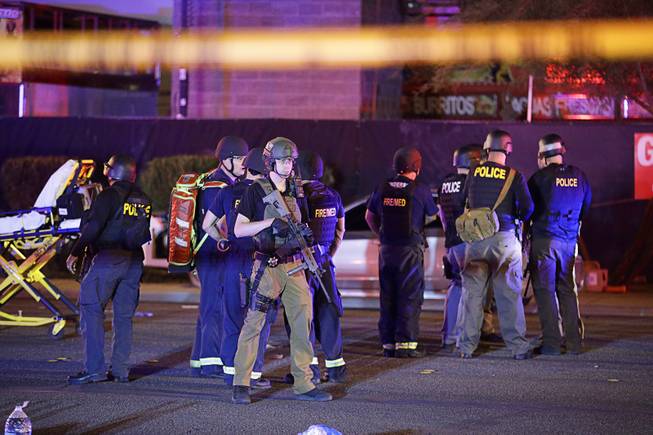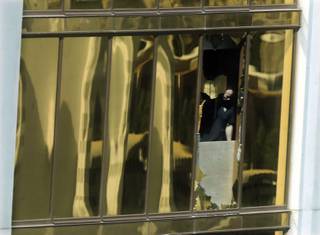
AP Photo/John Locher
Police officers and medical personnel are shown at the scene of a shooting near Mandalay Bay on the Las Vegas Strip, Monday, Oct. 2, 2017. Hundreds of victims were transported to hospitals after a shooting late Sunday at a music festival there.
Sunday, Oct. 22, 2017 | 2 a.m.
Rescue task forces
• Up to 7 armed police officers on each task force
• Up to 4 firefighter paramedics on each task force
• Wearing flak vests and helmets designed to withstand gunshots, teams of officers surrounding medics moved from patient to patient, treating and transporting them to ambulances while keeping them protected.
With shooting victims on the site of the Route 91 Harvest Festival and taking shelter in nearby hotels, police officers clustered around firefighters, protecting the paramedics as they worked to stabilize and move the wounded to safety.
The agencies had practiced together for years on these rescue task forces, preparing for the possibility of a mass-casualty event like the Oct. 1 massacre, which authorities said was perpetrated by a lone gunman firing from an elevated position inside Mandalay Bay.
“It seems rather aggressive, but we’ve learned from past incidents where people were injured and nobody pulled them out and, unfortunately, they died, where potentially they could have been saved,” said Joe Geeb, a Clark County fire captain based out of Station 33.
Geeb was referring to the traditional practice of fire departments waiting for police to deem a scene safe for medical crews, which has been changing in response to deaths from blood loss that might have been prevented after other mass shootings.
“We practiced this over and over,” Geeb said, “and we put that practice into action that night.”
Moving together in a “protective bubble” formation, Geeb thinks the teams of Metro Police officers and local firefighters from various municipalities saved several victims who might not otherwise have survived.
“I remember being a part of one of those rescue task force groups. We said, ‘We go in together, we go out together,’ ” Geeb recalled. “I know I’ve got their back, and they have mine. We say that sometimes, and it doesn’t resonate as much as it should.”
Given how effective the tactic was in responding to the shooting, law enforcement agencies in Las Vegas plan to utilize it for any similar incidents. And Geeb said the bond between first responders was stronger than ever. “After this event, I don’t think there is an officer or firefighter who just shakes hands — we hug now,” he said. “I may meet them for the first time, but a hug comes with it. Because we know what we’ve been through, and I want them to know that, hey, I’m here for you.”
Mass-Casualty Incident Unit
Components of the MCI unit
• Includes ballistic gear such as helmets and Level IV body armor vests, which are designed to withstand armor-piercing bullets.
• The engine carries tables, chairs, generators, water, cones and tarps for safety and staging an area for triage of wounded people.
• MCI unit members carry kits that are basically fanny packs containing materials for treating wounds, needles for releasing pressure on the chest caused by internal injuries, tourniquets and other items used in emergency care.
Another successful approach used by the firefighters that night was the deployment of their mass-casualty incident unit (MCI).
Geeb and Station 33 were tending to a dumpster fire when they heard what was happening near Mandalay Bay on the scanner radio. That station houses the MCI unit, which includes a fire engine and a rescue unit, so the crew jumped into action.
“So it’s three units responding as one big one,” Geeb said. “We’re responsible for responding and deploying all the equipment. We went back to the station immediately when the call went out, and we self-dispatched ourselves.”
The unit raced up Paradise Road to Tropicana Avenue while listening to the commotion at the scene through the scanner.
“At Tropicana and Koval, it was just people running away everywhere,” Geeb said. “We could see cars coming at us through the intersection, doors (open) with people hanging out of cars. People in the beds of trucks, filled — it looked like clothing because people were just mounded up.”
A few blocks ahead, where Tropicana and the Strip intersected, Geeb’s team set up the MCI and got to work.
“We began to triage, treat and then transport,” the captain said. “We had ambulances who were pulling up, who did an amazing job of getting in line and ready to transport these patients. We had a multitude of Clark County Fire Department members who were treating the people and handing them off to the ambulances while they would continue to treat them on the way to the hospital.”

